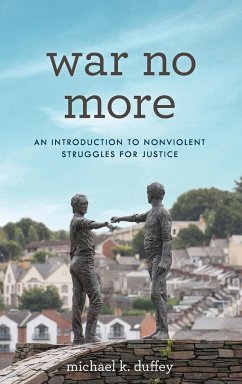- Gebundenes Buch
- Merkliste
- Auf die Merkliste
- Bewerten Bewerten
- Teilen
- Produkt teilen
- Produkterinnerung
- Produkterinnerung
This introduction to nonviolent movements analyzes fourteen classic and contemporary cases to show how nonviolent strategies can work where violent warfare has failed. Drawing on practitioner knowledge and diverse philosophical and religious texts, Michael K. Duffey offers a multifaceted argument for embracing nonviolent resolutions to conflict.
Andere Kunden interessierten sich auch für
![War No More War No More]() Michael K. DuffeyWar No More52,99 €
Michael K. DuffeyWar No More52,99 €![Resistance and Decolonization Resistance and Decolonization]() Amilcar CabralResistance and Decolonization137,99 €
Amilcar CabralResistance and Decolonization137,99 €![Just Liberal Violence Just Liberal Violence]() Michael NeuJust Liberal Violence126,99 €
Michael NeuJust Liberal Violence126,99 €![Generalist Approach to Conflict Resolution Generalist Approach to Conflict Resolution]() Toran HansenGeneralist Approach to Conflict Resolution118,99 €
Toran HansenGeneralist Approach to Conflict Resolution118,99 €![The Cultural Production of Social Movements The Cultural Production of Social Movements]() Robert F. CarleyThe Cultural Production of Social Movements91,99 €
Robert F. CarleyThe Cultural Production of Social Movements91,99 €![Foucault, Biopolitics and Resistance Foucault, Biopolitics and Resistance]() Lauri SiisiäinenFoucault, Biopolitics and Resistance55,99 €
Lauri SiisiäinenFoucault, Biopolitics and Resistance55,99 €![Animals Matter: Resistance and Transformation in Animal Commodification Animals Matter: Resistance and Transformation in Animal Commodification]() Animals Matter: Resistance and Transformation in Animal Commodification129,99 €
Animals Matter: Resistance and Transformation in Animal Commodification129,99 €-
-
-
This introduction to nonviolent movements analyzes fourteen classic and contemporary cases to show how nonviolent strategies can work where violent warfare has failed. Drawing on practitioner knowledge and diverse philosophical and religious texts, Michael K. Duffey offers a multifaceted argument for embracing nonviolent resolutions to conflict.
Produktdetails
- Produktdetails
- Verlag: Rowman & Littlefield Publishers
- Seitenzahl: 194
- Erscheinungstermin: 19. Juli 2021
- Englisch
- Abmessung: 235mm x 157mm x 15mm
- Gewicht: 440g
- ISBN-13: 9781538158579
- ISBN-10: 1538158574
- Artikelnr.: 61435908
- Herstellerkennzeichnung
- Libri GmbH
- Europaallee 1
- 36244 Bad Hersfeld
- gpsr@libri.de
- Verlag: Rowman & Littlefield Publishers
- Seitenzahl: 194
- Erscheinungstermin: 19. Juli 2021
- Englisch
- Abmessung: 235mm x 157mm x 15mm
- Gewicht: 440g
- ISBN-13: 9781538158579
- ISBN-10: 1538158574
- Artikelnr.: 61435908
- Herstellerkennzeichnung
- Libri GmbH
- Europaallee 1
- 36244 Bad Hersfeld
- gpsr@libri.de
Michael K. Duffey is associate professor emeritus and former director of the Interdisciplinary Major in Peace Studies at Marquette University. Duffey specializes in theological ethics with particular attention to issues of justice and peace, human rights, and Protestant and Catholic ethical methodologies. His most recent books are Sowing Justice, Reaping Peace: Case Studies of Racial, Religious, and Ethnic Healing Around the World and Peacemaking and the Challenge of Violence in World Religions (coedited with Irfan A Omar).
Preface
Introduction
Chapter One A Hundred Years of Horrific War-making
The Just War Tradition
World Wars I and II
Five U.S. wars of choice
The war after the war
When wars are unjust
Chapter Two Mohandas Gandhi, the father of modern nonviolent, and war
resistance
Early life and South Africa
Gandhi's principles
Gandhi's nonviolent campaigns in India
Nonviolent resistance to the Third Reich?
Nonviolent resistance in occupied Denmark
The rescue of Jews in Southern France
Chapter Three Successful Nonviolent Revolutions
"People Power" in the Philippines
Poland's and East Germany's victory against Communism
Serbia's "Otpor"
Tunisia and the beginning of the Arab Spring
Women's liberation in Liberia
Chapter Four Systemic Racism from the Civil Rights Struggle to the Black
Lives Matter Movement
U.S. Civil Rights Movements in the 1960s.
The Student Nonviolent Coordinating Committee
Malcolm X and the Black Panther Party for Self-Defense
Black Lives Matter
Chapter Five Nonviolent Struggles U..S. Farm Laborers, Native Americans,
and Black South Africans
La Causa: justice for migrant farm workers
Native Americans recovering the center
Ending Apartheid in South Africa
Chapter Six Violent America
Empire
Building, buying, and selling weapons
"Wars" on the home front
Citizen activism?
Chapter Seven Citizen Movements against Violence
Building blocks
Challenging U.S. violence abroad
Overcoming violence at home: systemic racism, poverty, and incarceration
Gun violence
Defending the environment
Chapter Eight Nonviolence, world religions, and the virtues
Hinduism, Buddhism, Sikhism, Judaism, Christianity, Islam, and Indigenous
Spiritualities
Empathy
Negative and positive "otherness"
Justice and mercy
Forgiveness and repentance
Afterword
Reaffirming the Power of Nonviolence
Ireland's violent journey to peace
How risky is nonviolence?
Appendix One Two Unsuccessful Nonviolent Struggles for Justice:
Egypt's Arab Spring and the Israel-Palestine conflict
Appendix Two A Thought Experiment: Could emancipation have been achieved
without the Civil War?
Abolition, Congressional accommodation, and the Civil War
Bibliography
Index
Introduction
Chapter One A Hundred Years of Horrific War-making
The Just War Tradition
World Wars I and II
Five U.S. wars of choice
The war after the war
When wars are unjust
Chapter Two Mohandas Gandhi, the father of modern nonviolent, and war
resistance
Early life and South Africa
Gandhi's principles
Gandhi's nonviolent campaigns in India
Nonviolent resistance to the Third Reich?
Nonviolent resistance in occupied Denmark
The rescue of Jews in Southern France
Chapter Three Successful Nonviolent Revolutions
"People Power" in the Philippines
Poland's and East Germany's victory against Communism
Serbia's "Otpor"
Tunisia and the beginning of the Arab Spring
Women's liberation in Liberia
Chapter Four Systemic Racism from the Civil Rights Struggle to the Black
Lives Matter Movement
U.S. Civil Rights Movements in the 1960s.
The Student Nonviolent Coordinating Committee
Malcolm X and the Black Panther Party for Self-Defense
Black Lives Matter
Chapter Five Nonviolent Struggles U..S. Farm Laborers, Native Americans,
and Black South Africans
La Causa: justice for migrant farm workers
Native Americans recovering the center
Ending Apartheid in South Africa
Chapter Six Violent America
Empire
Building, buying, and selling weapons
"Wars" on the home front
Citizen activism?
Chapter Seven Citizen Movements against Violence
Building blocks
Challenging U.S. violence abroad
Overcoming violence at home: systemic racism, poverty, and incarceration
Gun violence
Defending the environment
Chapter Eight Nonviolence, world religions, and the virtues
Hinduism, Buddhism, Sikhism, Judaism, Christianity, Islam, and Indigenous
Spiritualities
Empathy
Negative and positive "otherness"
Justice and mercy
Forgiveness and repentance
Afterword
Reaffirming the Power of Nonviolence
Ireland's violent journey to peace
How risky is nonviolence?
Appendix One Two Unsuccessful Nonviolent Struggles for Justice:
Egypt's Arab Spring and the Israel-Palestine conflict
Appendix Two A Thought Experiment: Could emancipation have been achieved
without the Civil War?
Abolition, Congressional accommodation, and the Civil War
Bibliography
Index
Preface
Introduction
Chapter One A Hundred Years of Horrific War-making
The Just War Tradition
World Wars I and II
Five U.S. wars of choice
The war after the war
When wars are unjust
Chapter Two Mohandas Gandhi, the father of modern nonviolent, and war
resistance
Early life and South Africa
Gandhi's principles
Gandhi's nonviolent campaigns in India
Nonviolent resistance to the Third Reich?
Nonviolent resistance in occupied Denmark
The rescue of Jews in Southern France
Chapter Three Successful Nonviolent Revolutions
"People Power" in the Philippines
Poland's and East Germany's victory against Communism
Serbia's "Otpor"
Tunisia and the beginning of the Arab Spring
Women's liberation in Liberia
Chapter Four Systemic Racism from the Civil Rights Struggle to the Black
Lives Matter Movement
U.S. Civil Rights Movements in the 1960s.
The Student Nonviolent Coordinating Committee
Malcolm X and the Black Panther Party for Self-Defense
Black Lives Matter
Chapter Five Nonviolent Struggles U..S. Farm Laborers, Native Americans,
and Black South Africans
La Causa: justice for migrant farm workers
Native Americans recovering the center
Ending Apartheid in South Africa
Chapter Six Violent America
Empire
Building, buying, and selling weapons
"Wars" on the home front
Citizen activism?
Chapter Seven Citizen Movements against Violence
Building blocks
Challenging U.S. violence abroad
Overcoming violence at home: systemic racism, poverty, and incarceration
Gun violence
Defending the environment
Chapter Eight Nonviolence, world religions, and the virtues
Hinduism, Buddhism, Sikhism, Judaism, Christianity, Islam, and Indigenous
Spiritualities
Empathy
Negative and positive "otherness"
Justice and mercy
Forgiveness and repentance
Afterword
Reaffirming the Power of Nonviolence
Ireland's violent journey to peace
How risky is nonviolence?
Appendix One Two Unsuccessful Nonviolent Struggles for Justice:
Egypt's Arab Spring and the Israel-Palestine conflict
Appendix Two A Thought Experiment: Could emancipation have been achieved
without the Civil War?
Abolition, Congressional accommodation, and the Civil War
Bibliography
Index
Introduction
Chapter One A Hundred Years of Horrific War-making
The Just War Tradition
World Wars I and II
Five U.S. wars of choice
The war after the war
When wars are unjust
Chapter Two Mohandas Gandhi, the father of modern nonviolent, and war
resistance
Early life and South Africa
Gandhi's principles
Gandhi's nonviolent campaigns in India
Nonviolent resistance to the Third Reich?
Nonviolent resistance in occupied Denmark
The rescue of Jews in Southern France
Chapter Three Successful Nonviolent Revolutions
"People Power" in the Philippines
Poland's and East Germany's victory against Communism
Serbia's "Otpor"
Tunisia and the beginning of the Arab Spring
Women's liberation in Liberia
Chapter Four Systemic Racism from the Civil Rights Struggle to the Black
Lives Matter Movement
U.S. Civil Rights Movements in the 1960s.
The Student Nonviolent Coordinating Committee
Malcolm X and the Black Panther Party for Self-Defense
Black Lives Matter
Chapter Five Nonviolent Struggles U..S. Farm Laborers, Native Americans,
and Black South Africans
La Causa: justice for migrant farm workers
Native Americans recovering the center
Ending Apartheid in South Africa
Chapter Six Violent America
Empire
Building, buying, and selling weapons
"Wars" on the home front
Citizen activism?
Chapter Seven Citizen Movements against Violence
Building blocks
Challenging U.S. violence abroad
Overcoming violence at home: systemic racism, poverty, and incarceration
Gun violence
Defending the environment
Chapter Eight Nonviolence, world religions, and the virtues
Hinduism, Buddhism, Sikhism, Judaism, Christianity, Islam, and Indigenous
Spiritualities
Empathy
Negative and positive "otherness"
Justice and mercy
Forgiveness and repentance
Afterword
Reaffirming the Power of Nonviolence
Ireland's violent journey to peace
How risky is nonviolence?
Appendix One Two Unsuccessful Nonviolent Struggles for Justice:
Egypt's Arab Spring and the Israel-Palestine conflict
Appendix Two A Thought Experiment: Could emancipation have been achieved
without the Civil War?
Abolition, Congressional accommodation, and the Civil War
Bibliography
Index









